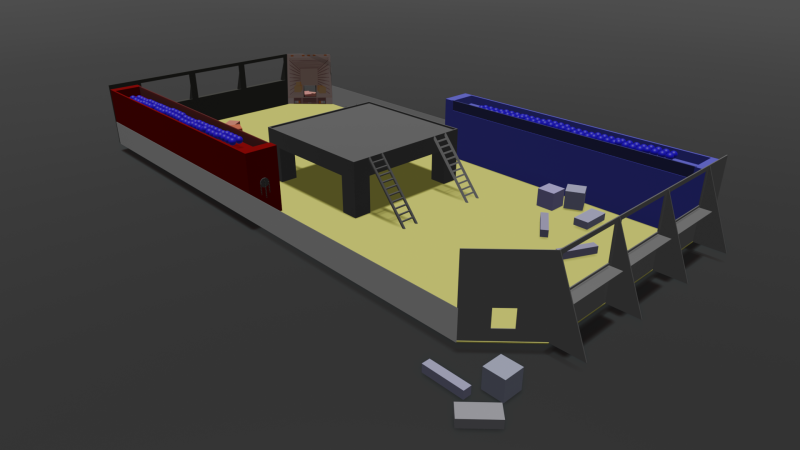Game Design Challenge
And Our Project: Overflow
For the 2021 FRC season, teams were unable to compete in person due to Covid-19. Instead, we participated in online challenges that acted in substation for in person/robot matches. For more information, please visit FIRST’s website.
Game Overview
FIRST Beach is about to flood, and it is your job to stave off the imminent flood, deliver SUPPLY BOXES to the FLOOD SHELTER, and escape by climbing the FLOOD SHELTER. Each alliance starts on one end of the field, and each robot can be preloaded with a SUPPLY BOX.
SUPPLY BOXES are lightweight boxes with irregular dimensions, with each dimension being from 2 to 15 inches. There are five different types of SUPPLY BOXES (12x12x2, 14x4x4, 10x10x10, 15x12x12, and 8x10x12 cubic inches). There are thirty SUPPLY BOXES on the field at the start of the game; one of each type against each FLOODGATE, two of each type under the FLOOD SHELTER, and one of each type opposite to each located near the FLOODGATE. Each team has two of each type of SUPPLY BOX behind their SUPPLY CRATE.
Each alliance has a SUPPLY CRATE located on the side of the field opposite of their robots and drivers. One human player stands behind the SUPPLY CRATE and delivers SUPPLY BOXES through it onto the field. There is a zone directly in front of the SUPPLY BOX. A robot on the opposing alliance is penalized if they enter that zone and are touched by a robot of that SUPPLY CRATE’s alliance.
For the first fifteen seconds, robots are autonomous, and can move out of the STARTING ZONE for three points and place SUPPLY BOXES onto the FLOOD SHELTER for six points each. There is a across the width of the field at the field’s center which robots are not allowed to cross during this time.
For the next two minutes and forty-five seconds, robots are tele-operated. Teams score SUPPLY BOXES by placing them on top of the FLOOD SHELTER for three points each. Alliances deliver SUPPLY BOXES to the field via their SUPPLY CRATE. Teams spin the WHEELS on their FLOODGATE to stop it from flooding. FLOODGATES have a thirty-second timer which starts at the start of the tele-operated period. Once this timer runs out, the FLOODGATE opens. Whenever the WHEEL is spun counterclockwise, the timer stops, and is rewound at a rate of one second per ninety degrees the wheel is turned.
For the final thirty seconds of the tele-operated period, robots climb using the LADDERS located on their side of the field. A robot climbs when it is touching the ladder, is over a foot above the field, and stays there for five seconds after the game ends. Once the game ends, points are added to each alliance’s score. Fifteen for each robot that has climbed, an additional fifteen if all three robots have climbed, and twenty if that alliance’s FLOODGATE is unopened.
Each alliance earns ranking points at the end of each game. One ranking point for the alliance that wins, one ranking point for each alliance that scored twelve or more SUPPLY BOXES and has an unopened FLOODGATE, and one ranking point to each alliance if there are twenty five or more SUPPLY BOXES on the FLOOD SHELTER.
Field Elements
The FLOOD SHELTER is a large 151x151 inch structure which is located at the center of the field. It is raised above the field on four 20x20 inch beams. The bottom ceiling of the FLOOD SHELTER is 42 inches above the field and its top platform is raised 60 inches above the field, with small 2 inch high walls along the top (to prevent SUPPLY BOXES from slipping off). There are four LADDERS affixed to the FLOOD SHELTER and the field at a 50 degree angle to the field, with two LADDERS on each side of the field.
Each LADDER is 20 inches wide, with the two long sides made up of round, 3 inch diameter beams. There are ten evenly spaced cylindrical rungs on each LADDER, each of which have a diameter of 2 inches. Each LADDER’s actual length is approximately 77.89 inches. Teams are allowed to climb onto the LADDER at the end of the game in any way they can find, meaning that there are multiple, unique ways to approach the challenge of climbing it.
FLOODGATES are large field elements which contain WATER (soft balls with a diameter of 4 inches) and which can drop the WATER down onto the field. FLOODGATES are 36 by 324.5 inches. Each alliance has a FLOODGATE on their side of the field which can spill the WATER onto their side, making movement significantly more difficult.
The WHEEL is a vertical disc which spins on its center, and which has four loose-hanging chains spaced evenly along its circumference. A WHEEL is located on each FLOODGATE on the side closest to the field. Robots spin the WHEEL using these chains in order to prevent the FLOODGATE from releasing the WATER.
Robot Actions
During the autonomous period, robots can be loaded with a SUPPLY BOX. It is likely that robots will be programmed to simply drive straight forward to the FLOOD SHELTER and place their pre-loaded SUPPLY BOX on top of it. Robots with more advanced autonomous capabilities will most likely then alternate between going under the FLOOD SHELTER to pick up a SUPPLY BOX and then placing the SUPPLY BOX on top of the FLOOD SHELTER.
Robots will most likely navigate through the field by driving under the FLOOD SHELTER. Although it is possible to navigate the field with a robot that can’t fit under it, this is made difficult by the two chokepoints on either side of the field, between the FLOOD SHELTER and FLOODGATES, where the WHEELS are also located.
Alliances will likely have at least one robot score points by cycling between the SUPPLY CRATE and FLOOD SHELTER to pick up SUPPLY BOXES and quickly score them. It is also likely that one robot will be responsible for defending its alliance’s side of the field and occasionally spinning the WHEEL on its FLOODGATE. Alliances will likely make some effort to defend their side of the field, in order to have access to their WHEEL and prevent the opponent from obtaining SUPPLY BOXES.
During the last thirty seconds, robots are able to climb the LADDERS on their alliance’s side to gain extra points. Most robots will likely go under a LADDER and attach themselves to a rung, but this realistically only allows for two robots to climb given the limited space. Alliances who want to climb all three robots will likely have at least one robot climb a LADDER from the top, which is an engineering challenge.


